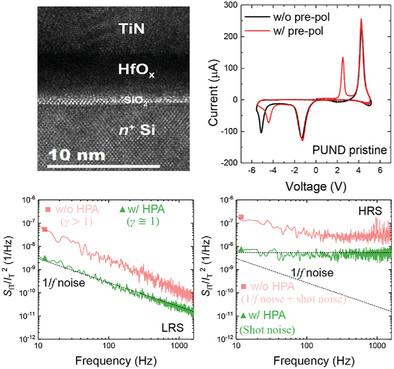当前位置:
X-MOL 学术
›
Adv. Electron. Mater.
›
论文详情
Our official English website, www.x-mol.net, welcomes your
feedback! (Note: you will need to create a separate account there.)
Effects of Charge Imbalance on Field‐Induced Instability of HfO2‐Based Ferroelectric Tunnel Junctions
Advanced Electronic Materials ( IF 5.3 ) Pub Date : 2024-11-04 , DOI: 10.1002/aelm.202400299 Wonjun Shin, Chang‐Hyeon Han, Jangsaeng Kim, Ryun‐Han Koo, Kyung Kyu Min, Daewoong Kwon
Advanced Electronic Materials ( IF 5.3 ) Pub Date : 2024-11-04 , DOI: 10.1002/aelm.202400299 Wonjun Shin, Chang‐Hyeon Han, Jangsaeng Kim, Ryun‐Han Koo, Kyung Kyu Min, Daewoong Kwon

|
Ferroelectricity in hafnium‐based materials has attracted significant research attention and is used in various applications owing to their complementary metal‐oxide‐semiconductor compatibility, scalability, and low‐power operation. However, their widespread integration into various technologies is hindered by reliability and stability problems, particularly field‐induced instability, which causes fluctuations in polarization characteristics during operation. Herein, on the underlying mechanism of field‐induced instability is reported in pure hafnium oxide films within metal‐ferroelectric‐insulator‐semiconductor (MFIS) ferroelectric tunnel junctions (FTJs). The comprehensive material analysis combined with low‐frequency noise (LFN) measurements reveals that the presence of oxygen vacancies and interface traps within the ferroelectric and dielectric layers induces a charge imbalance in the FTJ, leading to distortion in its polarization characteristics and the onset of cyclic evolution in field‐induced instability. Furthermore, high‐pressure annealing effectively mitigates field‐induced instability by reducing the defects within the film, thereby alleviating the associated charge imbalance. These findings contribute to a deeper understanding of the internal dynamics of FTJs and provide an efficient approach to enhancing their stability.
中文翻译:

电荷不平衡对 HfO2 基铁电隧道结场诱导不稳定性的影响
铪基材料中的铁电性引起了研究的广泛关注,并因其互补的金属氧化物半导体兼容性、可扩展性和低功耗操作而被用于各种应用。然而,它们被广泛集成到各种技术中受到可靠性和稳定性问题的阻碍,特别是场引起的不稳定性,这会导致运行过程中极化特性的波动。在此,报道了金属-铁电-绝缘体-半导体 (MFIS) 铁电隧道结 (FTJ) 内的纯氧化铪薄膜中场诱导不稳定性的潜在机制。全面的材料分析与低频噪声 (LFN) 测量相结合,表明铁电层和介电层中存在的氧空位和界面陷阱会在 FTJ 中诱导电荷不平衡,导致其极化特性失真,并在场诱导的不稳定性中开始循环演化。此外,高压退火通过减少薄膜内的缺陷来有效减轻场诱导的不稳定性,从而缓解相关的电荷不平衡。这些发现有助于更深入地了解 FTJ 的内部动力学,并为增强其稳定性提供了一种有效的方法。
更新日期:2024-11-04
中文翻译:

电荷不平衡对 HfO2 基铁电隧道结场诱导不稳定性的影响
铪基材料中的铁电性引起了研究的广泛关注,并因其互补的金属氧化物半导体兼容性、可扩展性和低功耗操作而被用于各种应用。然而,它们被广泛集成到各种技术中受到可靠性和稳定性问题的阻碍,特别是场引起的不稳定性,这会导致运行过程中极化特性的波动。在此,报道了金属-铁电-绝缘体-半导体 (MFIS) 铁电隧道结 (FTJ) 内的纯氧化铪薄膜中场诱导不稳定性的潜在机制。全面的材料分析与低频噪声 (LFN) 测量相结合,表明铁电层和介电层中存在的氧空位和界面陷阱会在 FTJ 中诱导电荷不平衡,导致其极化特性失真,并在场诱导的不稳定性中开始循环演化。此外,高压退火通过减少薄膜内的缺陷来有效减轻场诱导的不稳定性,从而缓解相关的电荷不平衡。这些发现有助于更深入地了解 FTJ 的内部动力学,并为增强其稳定性提供了一种有效的方法。


















































 京公网安备 11010802027423号
京公网安备 11010802027423号